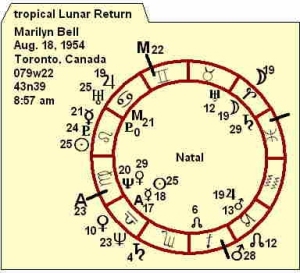If we want to find out how a Lunar Return works, then we work backwards.
In the case of Marilyn Bell we know that she entered Lake Ontario on Sept. 8, 1954 at 11:07 PM and reached the breakwater at Toronto, Canada on Sept. 9, 1954 at 8:06 PM. We will first look at the Lunar Return that occurred prior to Marilyn’s amazing feat of swimming across the lake. Following that effort, we will look at the transits for the date and time of her start and finish. (Edited to correct for prior chart misrepresentations)
 Would this Lunar Return chart shout out, “This is the month to make history, to swim across a lake?”
Would this Lunar Return chart shout out, “This is the month to make history, to swim across a lake?”
Transiting Mars near the IC: One makes an effort to start a big project.
Moon/Moon is in the 7th: Her support comes through others in her circle of family, friends, associates.
Natal Saturn near Descendant: A strategy or plan depends upon others.
These three angular factors, which would be used in a Sidereal or a precession-corrected Tropical chart are not very powerful in this conventional Tropical Lunar Return — not powerful enough for us to review it and say, “This is the month for something great to happen.”
So, knowing what was to happen a couple of weeks later due to recorded history, lets us “cheat” and just stretch things a bit. We see transiting Neptune broadly conjunct the Sun, but that is a transit that would have been in effect, and stronger, for many months prior to this Lunar Return date. L/R Ascendant conjunct natal Neptune would normally point to something dramatic, a dream or vision, perhaps a spiritual event. But, with both transiting and natal Ascendants and Neptunes involved, we have a powerful indicator staring us in the face! I call features such as this a “similarity pattern”. These are always worthy of our utmost attention!
So, let us say that this chart grabs our attention. “When” will something happen? That is the key issue, isn’t it. “When” will it happen? What can we look for, what will prove to be the trigger? One possible answer (and there are other possible answers) is to look at transiting planets.
What transiting planets? Let us look at transits for Sept. 8th and 9th, the dates that spanned her 20-plus hour swim. The Moon for starters, it is a Lunar Return chart. Moon was at 27 Capricorn at the start of her swim at 11:07 pm on the 8th, and at 9 Aquarius at the completion of her swim at 8:06 pm on the 9th of September. Transiting Moon was conjunct the IC and Lunar Return Mars at the start of her swim.
Sun moves to 15 Virgo on Sept. 8th — not significant. Mercury moves to 1 Libra, seemingly not a trigger. Venus moves to 1 Scorpio. Mars moves to 6 Capricorn. Jupiter ends up at 23 Cancer. Saturn only move to 5 Scorpio, while Uranus and Pluto hardly move at all, and the N.Node moves backwards. Only slow-moving Neptune makes a symbolic impact due to its connections with the natal and Lunar Return Ascendants.
We have worked this chart forwards and backwards. Using the date when something happened, we can see what was significant. Now, all we have to do is many more charts to see if similar factors are involved.
Now, one chart doen’t by itself tell us much. Yet. To see if transits at angles is workable and dependable for use in Lunar Returns, and to check out these “similarity patterns”, we will need to examine many Lunar Returns. Before we consider taking that step, we will (in the next post) take another approach to using Lunar Returns as a possible predictive tool. As always, leave a comment here or e-mail me at dadsnook@charter.net Dave
